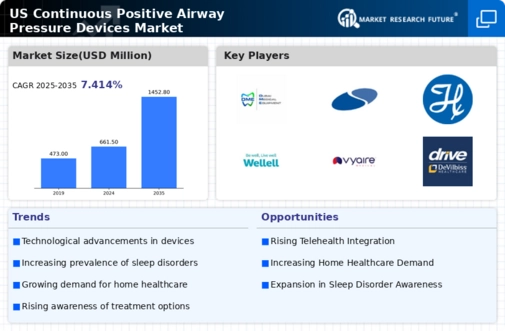Rising Healthcare Expenditure
The increasing healthcare expenditure in the US is a crucial factor driving the continuous positive-airway-pressure-devices market. As healthcare spending continues to rise, patients are more likely to seek treatment for sleep disorders, including sleep apnea. According to the Centers for Medicare & Medicaid Services, national health expenditure is projected to grow at an average rate of 5.4% annually, reaching approximately $6 trillion by 2027. This growth in healthcare spending is likely to facilitate greater access to CPAP devices, as insurance coverage expands and more patients are able to afford necessary treatments. Additionally, the emphasis on preventive care and chronic disease management may lead to increased screening for sleep apnea, further boosting demand for CPAP therapy. As a result, the continuous positive-airway-pressure-devices market stands to benefit from the overall increase in healthcare investment.
Increasing Prevalence of Sleep Apnea
The rising incidence of sleep apnea in the US is a primary driver for the continuous positive-airway-pressure-devices market. Studies indicate that approximately 22 million Americans suffer from sleep apnea, with a significant portion remaining undiagnosed. This growing prevalence necessitates effective treatment options, leading to increased demand for CPAP devices. As awareness of sleep disorders expands, healthcare providers are more likely to recommend CPAP therapy, further propelling market growth. The continuous positive-airway-pressure-devices market is expected to benefit from this trend, as patients seek reliable solutions to manage their condition. Moreover, the financial burden associated with untreated sleep apnea, including increased healthcare costs and reduced productivity, underscores the importance of effective treatment options, thereby enhancing the market's potential.
Aging Population and Healthcare Needs
The aging population in the US is a significant driver for the continuous positive-airway-pressure-devices market. As individuals age, the likelihood of developing sleep apnea and other respiratory conditions increases. The US Census Bureau projects that by 2030, all baby boomers will be over 65 years old, leading to a higher demand for healthcare services, including CPAP therapy. This demographic shift is likely to result in a surge in the number of prescriptions for CPAP devices, as older adults seek effective treatments for sleep-related disorders. Furthermore, healthcare providers are increasingly recognizing the importance of addressing sleep apnea in older patients, which may lead to more proactive screening and treatment initiatives. Consequently, the continuous positive-airway-pressure-devices market is poised for growth as the healthcare system adapts to the needs of an aging population.
Technological Innovations in Device Design
Technological advancements in the design and functionality of CPAP devices are significantly influencing the continuous positive-airway-pressure-devices market. Innovations such as quieter machines, improved comfort features, and enhanced portability are making CPAP therapy more appealing to users. For instance, the introduction of auto-adjusting pressure settings and integrated humidifiers has improved user experience and compliance rates. The market is projected to grow as manufacturers invest in research and development to create more user-friendly devices. Additionally, the integration of smart technology, such as mobile app connectivity for monitoring sleep patterns, is likely to attract a tech-savvy demographic, further expanding the market's reach. These innovations not only enhance patient satisfaction but also contribute to better health outcomes, reinforcing the importance of CPAP therapy.
Enhanced Patient Education and Support Programs
Enhanced patient education and support programs are emerging as vital drivers for the continuous positive-airway-pressure-devices market. Healthcare providers are increasingly recognizing the importance of educating patients about sleep apnea and the benefits of CPAP therapy. Comprehensive education initiatives, including workshops, informational resources, and support groups, are being implemented to improve patient understanding and adherence to treatment. These programs aim to address common concerns, such as device comfort and usage, which can significantly impact patient compliance. As patients become more informed and supported, they are more likely to invest in CPAP devices, thereby driving market growth. Furthermore, the establishment of online communities and resources has made it easier for patients to share experiences and seek advice, fostering a supportive environment that encourages the use of continuous positive-airway-pressure-devices.





















Leave a Comment